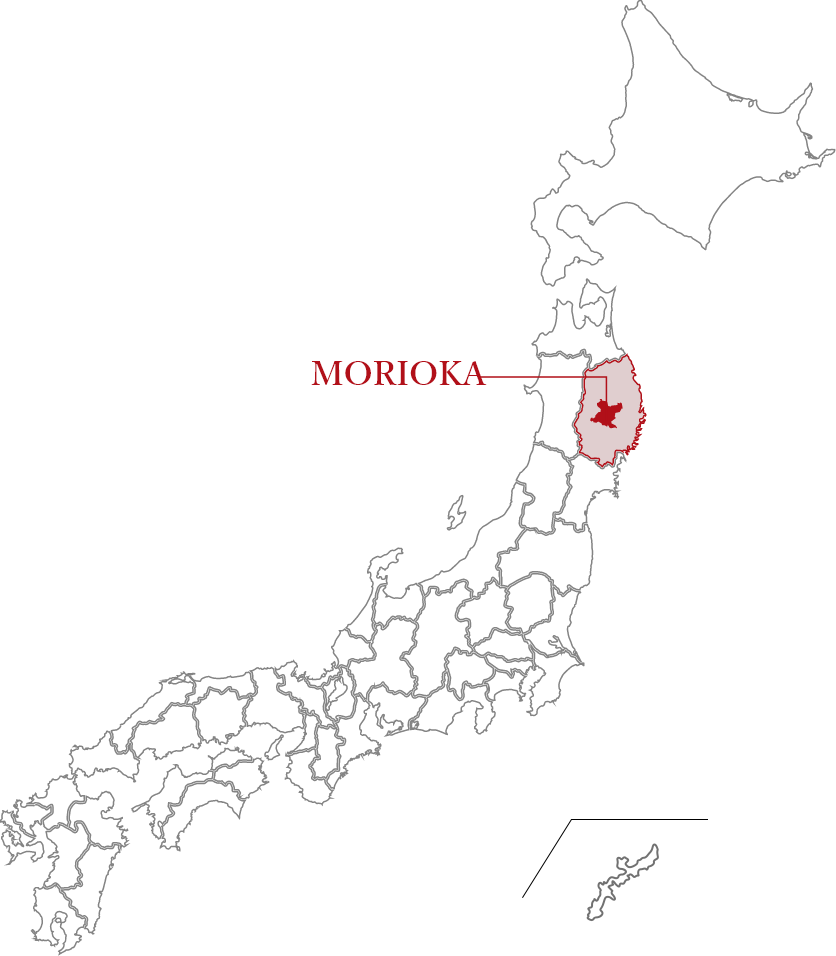morioka Cherry Blossoms 2023
Morioka Cherry Blossom archives 2023

Author Craig Modo praised Morioka as "a gem of a city you can walk around" and it was the second city introduced to the public after London, England.
"Morioka Journey" introduces Morioka's beautiful scenery, traditional culture, historical buildings, and scenic nature, as well as Morioka's seasonal charms through video clips taken by Morioka residents.



Morioka City has three famous local noodle dishes called "three major noodle".
One of them is "rei-men" a cold noodle dish featuring firm noodles and a spicy beef bone-based soup.
Toppings include boiled eggs, kimchi, chashu, and in some restaurants, fruit.
Morioka City has three famous local noodle dishes called "three major noodles".
One of them is "wanko soba" an all-you-can-eat style noodle dish where you are served bite-sized buckwheat noodles in a small bowl.
It is said to have originated in Hanamaki City, and is such a popular hands-on gourmet experience that a "Wankosoba Tournament" is held there.
Morioka City has three famous local noodle dishes called "three major noodle".
One of them is "jaja-men" a noodle dish in which flat udon-like noodles are mixed with meat miso and served with vinegar, raayu, garlic, and other ingredients to taste.
One of the charms of "jaja-men" is that you can enjoy "chi-tan-tan" a soup made by adding a raw egg, boiled water, and meat miso paste to the bowl after the noodles are finished.
Iwate is a major rice-producing region.In the Morioka area, rice planting takes place from mid to late May every year.
Seedlings that have grown to 15 to 20 centimeters in height are planted in the silvery rice paddies.
In the fall, the golden rice plants bear abundant harvests and we receive the bounty of the earth.
Morioka Hachiman-gu Shrine holds the koshogatsu events “Dondonsai” and “Naked Pilgrimage” on January 15.
In the “Dontonsai” ceremony, New Year's decorations and good luck charms brought from each household are burned, and the fire is lit to pray for good health and safety for the year.
“Morioka Naked Pilgrimage” is a traditional event for the New Year that has continued for about 200 years since the Edo period (1603-1868).
Men dressed in underclothes wrap a sacred rope around their waists and parade through the town in the bitter cold, praying for good health, a good harvest, and the safety of their families.
Morioka Autumn festival has been a tradition for over 300 years.
It is said that the festival originated when the symbols of each town were dedicated to the Morioka Hachiman Shrine to celebrate the completion of the 23 towns under Morioka Castle in the Nanbu domain.
Gorgeous floats, each accompanied by a young man or woman, parade through the city, beating Taiko drums and playing the traditional Nanbu Ondo.
Hatsumode (New Year's visit) in Morioka.
Morioka Hachimangu Shrine, which was built more than 300 years ago, is said to attract more than 200,000 worshippers on three days every year.
Also in the center of Morioka City, adjacent to the ruins of Morioka Castle, is the Sakurayama Shrine, where the local deity of protection is enshrined.
Although there was no snow this year, many people visited the shrine to pray for good luck and good health for the year ahead.
This is a traditional Bon Festival event held every year on August 16th in Morioka.
Boats are decorated with lanterns and Bon offerings and floated on the Kitakami River. The boats are then set aflame and floated down the river to send off the spirits of ancestors along with lanterns and pray for good health and safety.
Held for four days from August 1 each year, this festival has been held for 350 to 400 years and is a symbol of summer in Morioka.
The origin of this festival is said to be the legend of Mitsuishi, from which Iwate Prefecture takes its name.
The choreography and costumes differ depending on the participating groups, and the parade is a spectacular sight as they march to the accompaniment of flutes, drums, and shouts of "Saccholachoiwayasse" (Saccholachoiwayasse).
The sound of bells announces the arrival of early summer, a tradition in this area.In this traditional event, which has been held for more than 200 years to express gratitude to farm horses, horsemen and women dressed in brightly colored costumes march "chug-chug" along a 14-kilometer route from Onikoshi Souzen Shrine to Morioka Hachiman Shrine.The sound of bells echoing through the hometown is registered as one of the 100 best soundscapes in Japan.
Located almost in the center of Iwate Prefecture, Morioka prospered as a castle town of the Nanbu domain (200,000 koku) and is surrounded by beautiful mountains. The town center is rich in nature with clear streams flowing through it, and the stone walls and nostalgic Western-style architecture of Morioka Castle Ruins Park create an attractive townscape.Morioka is also a place where one can feel the footprints of great writers such as Kenji Miyazawa and Takuboku Ishikawa, and is a charming town where one can enjoy traditional crafts and culture such as Nambu ironware.
This modern Japanese-style building was built in 1885 as the residence of Yasugoro Segawa, a businessman from Morioka City.It was once used as a guest house for Morioka and has been visited by many celebrities such as Hirobumi Ito and Takashi Hara. The polished floor surface reflects the beautiful trees of the garden, and the seasonal colors are enjoyed as "tokomidori" and "tokomomiji".
This 4.6m root circumference, 10m high Edohigan-zakura cherry tree, which grows out of a huge granite rock with a circumference of 21m, is a national natural treasure.
It is said that cherry tree seeds flew into a crack in the garden stone of a Nanbu domain retainer's mansion, sprouted, and pushed the crack open as the tree grew. Its imposing appearance is breathtaking, and its vigorous vitality is inspiring.
Morioka Castle is a park developed on the site of the former castle of the Morioka Domain and is designated as a national historic site. Morioka Castle is characterized by its stone walls, which are rare in eastern Japan, and the collaboration of the beautiful stone walls that remain today with cherry blossoms in full bloom is also "Instagrammable" (beautiful).
The park is home to approximately 200 cherry trees, including someiyoshino, sato-zakura, and edohigan-zakura. The Morioka Cherry Blossom Festival is held every year, attracting many cherry blossom viewers.
It is a popular spot for citizens to relax in all four seasons, with cherry blossoms in spring, autumn leaves in fall, and swans flying in winter. There are approximately 1,260 cherry trees, including weeping cherry and yae cherry, and it has been selected as one of the "100 Best Cherry Blossom Viewing Spots in Japan.
A promenade surrounds the pond, so we recommend taking a stroll while viewing the cherry blossoms. On a clear day, you can also see the magnificent view of Mt.
Completed in 1934, this is the oldest water purification plant in Morioka City.
There are about 30 Yaeveni shidare higan cherries planted on the site when it was first completed, and they are protected as trees of scenic importance by Morioka City. The graceful blooming of the cherry trees is truly the "Queen of Cherry Blossoms. The Yaebenishidare Higanzakura is usually off-limits to the public, but is open to the public only when the cherry blossoms are at their best.
Access to Morioka City
<Tohoku Expressway>
Kawaguchi JCT ─ Morioka: About 5 hours and 30 minutes for about 512 kilometers
Sendai-miyagi ─ Morioka: About 2 hours for about 180 kilometers
Aomori ─ Morioka: About 2 hours for about 167 kilometers
<Tohoku Hokkaido Shinkansen>
Tokyo ─ Morioka: 2 hours and 10 minutes (falcon), 2 hours and 31 minutes (squall) and 3 hours and 04 minutes (echo)
Sendai ─ Morioka: 39 minutes (falcon), 45 minutes (squall) and 1 hour and 04 minutes (echo)
New Aomori ─ Morioka: 47 minutes (falcon) and 58 minutes (squall)
New Hakodate Hokuto ─ Morioka: 1 hour and 46 minutes (falcon) and 2 hours and 04 minutes (squall)
<JAL (JAL)>
oosaka(itami)─hanamaki:1 hour and 20 minutes
sapporo(chitose)─hanamaki:55fun
Fukuoka ─ Hanamaki: 1 hour and 55 minutes
<FDA (wisteria dream airlines)>
nagoya(komaki)─hanamaki:1 hour and 10 minutes
Kobe ─ Hanamaki: 1 hour and 25 minutes